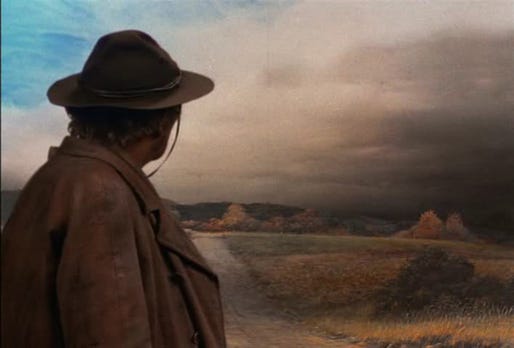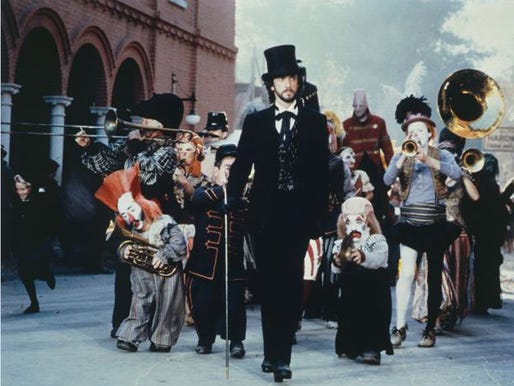Class of 1983: "Something Wicked This Way Comes"
In the “Class of …” series, we take a monthly look back at films celebrating either their 20th or 30th anniversary of initial release this year — six from 1993 and six from 1983. The rules: No Oscar nominees and no films among either year’s top-10 grossers.
With a bullet in my temple as the alternative, I’d be a dead man if pressed to recall exactly the first, or even the last, time I saw 1983’s “Something Wicked This Way Comes.” (Educated guesses? 1985 and 1990.) However unmoored the film has become from my chronological recollection, it nevertheless remains firmly fixed in my brain — a paranormal projectile lodged there since pre-pubescence.
Similarly, I can’t remember whether I watched it with parental permission — it was a Disney movie after all, no matter how dastardly — or simply circumvented their admittedly weak content barriers. Regardless, “Wicked” was the first full-fledged horror film I ever saw, at least as its filmmakers intended. Getting to watch “Friday the 13th” with your older brother and his high school friends sounds cool … until he makes you hide behind the couch and cover your ears during all the good stuff.
It was inevitable, my collision with “Wicked.” Invoking Shakespeare’s witches on the heath, its title takes on the cadence of a deadly incantation I couldn’t resist. And the evocative artwork on the chunky-clamshell VHS case beckoned to me from the shelves of my hometown’s gas-station-cum-video store.
Storm clouds and lightning frame scenes of a carnival enmeshed by shadowy penumbras and encased, as if inside a crystal ball, by the demonically splayed hands of a bearded man whose placid expression belies evil plots. At its center are two young boys — not much older than me at the time — running headlong, inexorably, toward the carnival’s dark magic. Their adventure, I dreamed, would be mine, too, if I dared to watch. And “Wicked’s” sinister storyline — adapted by Ray Bradbury from his own novel — saturated my curiosity for what its sinister storyline entailed.
In it, the people of a tiny Illinois town — similar to mine in size and social structure, albeit set in the past — fall prey to promises of having their wildest dreams come true. By day, Dark’s Pandemonium Carnival offers ordinary amusements. By night, under the aegis of its proprietor, Mr. Dark (Jonathan Pryce), it becomes a tent of temptation.
That’s fitting for an attraction that seemed to arrive as if by astral apparition, the whistle of its train wailing like human souls it’s collected along the way. And Dark is introduced at the edge of the frame, scattering his handbills in the town square; he knows the wind will spirit them toward those most likely to succumb. Think Stephen King’s “Needful Things” without all the blood and nihilism.
Endowed with supernatural powers, Mr. Dark bequeaths an exotic harem to the town’s lonely, lovesick barber. He restores beauty and youth to a curmudgeonly old biddy. He makes a war veteran whole and restores him to his childhood form as a budding young football player. Ah, but at what cost?
Sneaking into the carnival one night, best friends Will Halloway (Vidal Peterson) and Jim Nightshade (Shawn Carson) discover Mr. Dark’s secret — a carousel that spins backward and forward, shedding or adding years to its riders’ lives. After their discovery, the boys go on the run and Mr. Dark gives subdued chase. Although the threat of physical menace is high, Mr. Dark preys more strongly on the pending schism in Will and Jim’s friendship, as well as the vulnerability of Will’s aged father, Charles (Jason Robards), whose paternal love is plagued by secrets and shame.
Many of the movie’s moments were immediately and indelibly scary to me: the siege of spiders in one boy’s bedroom; a vision of Will’s decapitation; Mr. Dark’s parade of freaks large and small — as deformed as possible within PG-rating confines — stalking Will and Jim; Charles’ hand splitting open like the husk of a rotting pear; the helpless flailing of a woman gone blind; and the gruesome practical-effects demise in the film’s climax.
But even then, the ease with which these people gave in to Dark’s Pied Piper frightened me most. They appeared youthful, but their souls felt entombed, their eyes distant and detached from humanity or happiness — in particular Cooger, a hulking giant de-aged by Mr. Dark into a ghoulish, redheaded scamp.
These people weren’t truly alive, my young mind reasoned, but forever trapped in a covenant with a very scary devil. (Years passed before I could separate Pryce from the dread and anxiety with which Mr. Dark filled me.) I couldn’t have possibly articulated it then, but clearly evident was the idea that we can learn nothing from the passage of time if we’re able to so easily transcend it. (Also not lost on me then: the visual appeal of Pam Grier as a buxom succubus known as the Dust Witch.) As years passed, I emerged from behind the couch for bloodier frights, but few lingered like this.
“Wicked” was a milestone movie of my youth, which makes revisiting it inherently perilous. There’s nothing like passing time and changing tastes to immediately dim the bulb that burns so brightly at the multiplex of the memory.
As a boy, I had no knowledge of “Wicked’s” troubled, protracted production, but certain aspects of it are readily apparent now. The spider scene maintains icky intensity, but the boys are noticeably older in a scene clearly shot after principal production.
The film also glosses over much of the allegedly looming rift between Will and Jim; the latter seems in a hurry to acquire adulthood’s tantalizing, taboo knowledge while the former still seems content with childish things. Plus, any identification I had with these boys then stemmed only from my proximity to their ages — not the boilerplate performances that Peterson and Carson turn in.
But even amidst its more readily apparent imperfections, “Wicked” still holds a melancholy grip over me. That’s because its supernatural elements are really but a grace note to the symphony of its everyday drama, whose elegant, elegiac qualities have diminished little and with which I still sympathize, however differently as I did back then.
Bradbury originally wrote “Wicked” as a screenplay, which Gene Kelly allegedly wanted to make in 1952 but couldn’t raise the money. A decade later, Bradbury converted it into a novel and sold the movie rights to Paramount in 1977. After they put it in turnaround, Disney pounced on the possibility to make the film — the family-friendly studio seeking its own advanced-ages entry to compete with such edgier fantasy tales as “Time Bandits.”
The studio tapped director Jack Clayton, an Oscar nominee nevertheless best known for 1974’s dishwater-dull adaptation of “The Great Gatsby.” Earlier in his career, Clayton directed “The Innocents,” an adaptation of Henry James’ “The Turn of the Screw” that Martin Scorsese has called one of the scariest horror films of all time.
Rather unsurprisingly, the marriage of horror to Disney’s commercial preferences became an uneasy match. Filmed in 1981, “Wicked” was scheduled for release in 1982 but delayed after disastrous test screenings. Writer John Mortimer performed an uncredited rewrite. New special effects sequences were shot. James Horner’s 11th-hour replacement score shamelessly cribbed melodies from “The Imperial March.” When it tested poorly again, the release was pushed back even further, with Bradbury writing new opening narration and a new ending sequence.
(A note on that new narration: I’ve not read the novel, so I don’t know how much of this passage is verbatim, but the film’s literary pedigree is intractably established by this opening voiceover. “It was October, a rare month for boys, full of cold winds, long nights, dark promises. Days get short. Shadows lengthen. The wind warms in such a way you want to run forever through the fields because up ahead, 10,000 pumpkins lie waiting to be cut.” Rarely has autumn’s description felt so precise and poetic.)
All of this tinkering cost $5 million on top of the initial $20 million budget — for a movie that would make just $8.4 million. In the end, “Wicked” likely proved too edgy and existential for what was ostensibly meant as a slightly more dangerous Disney film. But it does what all of Bradbury’s greatest works do — shine a harsh light on the consequences of choices, the inevitability of aging, and the true cost of shame, greed, vanity, anxiety and other very human fears.
Bradbury’s script imbues the small-town setting with simultaneous conviviality and vulnerability, defining its residents as much by their secrecy as their decency. It’s an idea never more skillfully conveyed than through the weary hands, mouth and eyes of Robards — who beat out Walter Matthau, Jack Lemmon and Hal Holbrook, among others, to play the part of Charles.
Charles is a man for whom fatherhood arrived late in life, and the start of “Wicked” finds him at a dispiriting crossroads. He wants to impart necessary knowledge to Will but realizes his age isolates and distances him from more traditional fatherly bonds of physical play. He also suffers from the shame of a fearsome paralysis in his past — an inability to save his own drowning son because he didn’t know how to swim. (Jim’s father heroically dove in to save Will instead.)
Bradbury spikes a rarely tapped vein of paternal dread here, and uses it as a powerful, lyrical entry point to pit Charles against Mr. Dark. Theirs is an inclement battle of ideals rather than one of physical violence. Furthermore, the stakes are perfectly high for a father who feels powerless to protect his son but must summon the strength to save the boy from the devil himself — a devil who’s merely threading puppet strings for Charles and preparing to move him in ways he mastered long ago.
Robards and Pryce play these scenes of conversational confrontation like consummate pros, and two of them remain classically chilling still today. For those of us who’ve lived long enough to sense one autumn merging ceaselessly into the next, Dark’s macabre illustration of time’s passage won’t feel much like a dramatic exaggeration. And the sound design is haunting during a climactic meeting in Mr. Dark’s hall of mirrors, which resembles a forest about to swallow Charles whole.
So stately and calm is Robards’ portrayal of Charles’s anger, guilt and seeming inferiority throughout that it makes his ultimate victory over both Mr. Dark and his own self-imposed cycle of blame all the more triumphant. And his eventual embrace of his lends depth to the film’s fervent, poignant themes about time — namely how, as children, we ache for it to disappear and, as adults, rage in futility to get it back rather than enjoy what we have left.
On both the printed page and screens large and small, Bradbury enjoyed a long, legendary career by conflating fantastic premises with potent emotional wallops. One of his acolytes, Guillermo del Toro, is a similarly inclined hyphenate who necessarily mixes the playful and painful to impart insights about life’s beauty and brutality.
So it’s not unexpected that del Toro would eulogize Bradbury so eloquently upon his death in 2012, saying “A humanist before anything else, Bradbury nurtured my youthful hopes, my flights of fancy. His soul was gentle, but his imagination was fierce.” In “Something Wicked This Way Comes,” Bradbury’s curious combination of ferocity and generosity remains as compelling and bewitching in my third decade as it did in third grade.
Previous Class of 1983 Entries
The Dead Zone The Outsiders Twilight Zone: The Movie
Class of 1993 Entries
Demolition Man Last Action Hero So I Married an Axe Murderer This Boy's Life




